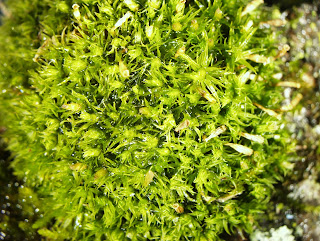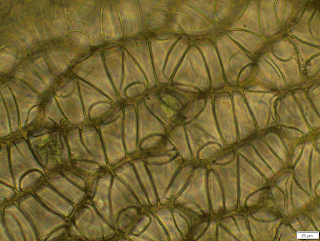 |
| Figure 1. Upper cortex of Flavoparmelia with soredia |
 |
| Figure 2. K- upper cortex of Flavoparmelia |
 |
| Figure 3. White medulla of Flavoparmelia |
 |
| Figure 4. lower cortex and rhizines of Flavoparmelia// |
Phylum: Ascomycota
Family: Parmeliaceae
Genus: Flavoparmelia
Collection date: October 2015
Collector: Willa Scharlu
Habitat: Found growing upon moss in South Russell, Ohio
Description: This foliose lichen. The upper cortex is a grayish green. Soredia are fairly common. The medulla is white. The lower cortex is a dark brown, and the rhizines are numerous and brown. It is K- and C+.
Key used: Showman, R. E. & D. G. Flenniken. (2004). The macrolichens of Ohio. Columbus, Oh; Ohio Biological Survey.
1. Thallus foliose...
2. Thallus some shade of gray, green, yellow-green, brown, or black; not as above...
4. Thallus thick or thin, not gelatinous when wet; white medullary fibers usually apparent; color various...
6. Rhizines present from lower surface (may be massed as a felty mat or umbilicate)...
11. Perithecia absent; apothecia, if present, saucer-shaped and superficial on the surface of the thallus...
13. Thallus not umbilicate, broadly attached to the substrate with scattered rhizines; onrock, soil, or bark...
15. Thallus containing green algae...
19. Medulla white or whitish, sometimes stained pale buff or pink due to aging, chemicals, or weathering...
24. Thallus various, but without paw-shape or fist-shaped lobe tips...
26. Lower surface with sparse to moderate or occasionally nmerous rhizines, variable in color and length but not forming a uniform , brown, velvety nap...
28. Upper cortex K- or K+ yellow (atranorin); lobes variable in width...
29. Lower surface with a cortex throughtout; lobes narrow or broad; K+ or K-...
30. Thallus without pores, may be uniform or variously cracked, ridged, or white-maculate...
35. Thallus yellow-green in color, usnic acid present...
56. Lobes quite broad, appically round, 3-10 mm wide...
57. Margins of lobes not ciliate...
58. Upper surface without white pores; medulla C-, or C+...
Flavoparmelia
For more information on Flavoparmelia please review the following links:
http://lichenportal.org/portal/taxa/index.php?taxon=54388
http://www.lichens.lastdragon.org/Flavoparmelia_soredians.html
https://www.anbg.gov.au/abrs/lichenlist/FLAVOPARMELIA%20Genus%20and%20Key.pdf













































